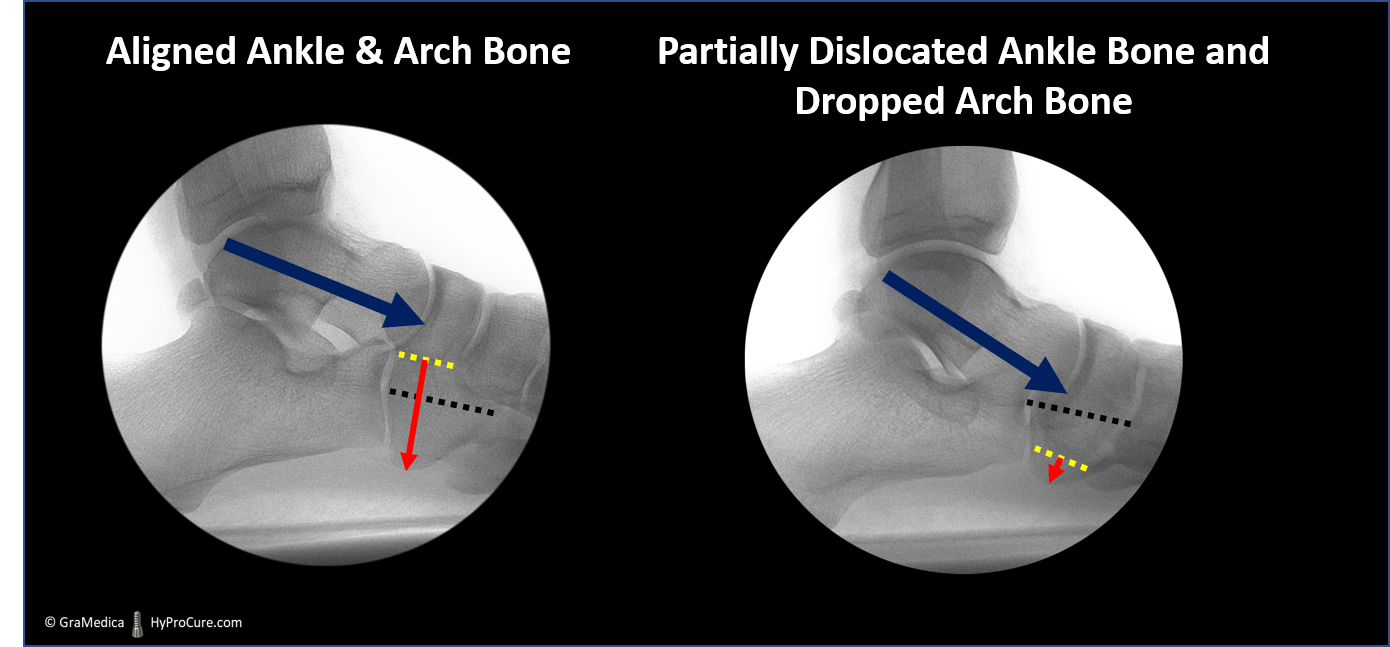Misaligned/over-pronated feet
What causes a foot to over-pronate?
The motion of the ankle bone on the hindfoot bones (heel and arch bones) is directly responsible for pronation. When the ankle bone partially dislocates on the heel bone, an excessive amount of foot pronation exists. How do we know this? The fusion of a partially dislocated (fixed or flexible) ankle bone on the heel bone (subtalar arthrodesis) eliminates hindfoot pronation.
It is very important to note that the source of over-pronation is occurring above the heel bone. The exact location is between the ankle and heel bones. The treatment of over-pronation will be needed to stabilize the ankle bone on the heel bone.


The ankle bone partially dislocates during standing, walking, or running. The ankle bone loses its stability and is in a pronated position longer than it should be. There is a second component that occurs between the small bone in front of the arch bone and long first metatarsal bone. Instability at the joint can cause excessive forefoot pronation. An over-pronating foot begins with the instability of the ankle bone and can be further complicated with the instability of the base of the first metatarsal bone.

It is worth noting that some authors have claimed that over-pronation is due to a ligament disease or that it is a worn-out, over-stretched tendon. Those tissue diseases can be present in an over-pronating foot, but not always. The partial dislocation of the ankle bone will over-stretch the ligaments and tendons. The partial ankle bone dislocation is always present before the ligaments and tendon over-stretching. Many times, surgeons have attempted to repair the damaged ligaments or tendons without addressing the ankle bone instability. The repair seemed to do-the-job at first, but after a while of the excessive ankle bone motion pushing on the bones and joints, that repair became compromised and ultimately failed.
Why is an over-pronating foot a “bad” thing?
Too much of anything is usually a bad thing, except money – some may argue. Excessive, prolonged duration of pronation during the walking cycle places an excessive strain on the bones, joints, ligament, tendons, fascia, and even nerves. All of the structures can handle a certain amount of strain, but when there is an excessive force applied tens of millions of times, a critical point is reached when the tissues can no longer accommodate that strain. Once that critical tissue strain threshold is reached, the tissues will become inflamed. That is usually a warning signal that something is wrong. That is when you develop heel pain, numbness/tingling to your toes, pain to the inner arch, or under the ball of your foot. Those are all of the secondary symptoms related to over-pronation and specifically to ankle bone instability.
The list of secondary disease entities associated with over-pronation all stems from that partially dislocating ankle bone. There is a progression of problems that can occur. Every person has a unique set of symptoms that develop as a result of their ankle bone instability derived from over-pronation. For that reason, it is called over-pronation or ankle instability syndrome. Certain tissues in some people will be stronger than others. The weakest link in the musculoskeletal chain will become weakened until it becomes painful. Loss of the stability of that stabilizing structure will lead to increased strain to other structures until those structures fail to compensate for the excessive strain and they become painful. That cycle will continue to progress to other stabilizing tissues of the body.
Parts of the foot that are strained/damaged because of an over-pronating foot:
- Spring ligament – calcaneal-navicular ligament
- Growth plate on the back of the heel bone
- Plantar fascia
- Posterior tibial tendon
- First metatarsal bone – at the base where it attaches to the arch bone
- Big toe joint
- Ball of the foot – metatarsalgia
- Toes – develop hammertoes
Then up towards the body:
- Nerve behind the inner ankle bone
- Achilles tendon/calf muscles
- Ankle bone
- Knee
- Hip
- Pelvis
- Spine
- Shoulders
Some claims have been made that even the neck, head, and jawbone can be negatively affected.
What is the best form of treatment for an over-pronating foot?
Treatment of an over-pronating foot has to begin at the source of the over-pronating foot – ankle bone instability. The stability of the ankle bone has to first be restored. Failure to fix the partial dislocation of the ankle bone on the heel will compromise the success of any other form of treatment.
Insertion of HyProCure into the sinus tarsi space is the first and most effective step in the treatment of over-pronation, assuming the ankle bone can be repositioned on the heel bone. Any other form of treatment is subtherapeutic or over-aggressive. HyProCure fixes the problem of over-pronation at the root. Once HyProCure is inserted, the ankle bone is stabilized and the excessive strain that was acting on all of the other supporting tissues will instantly be reduced.
Once the ankle bone stability has been fixed, then the other diseased tissue may heal without any other form of treatment, or they will have to be addressed with a conservative or surgical measure.
What happens if I don’t treat an over-pronating foot?
Failure to effectively normalize the amount of pronation in the foot results in a downward spiral of tissue strain to the ligaments, tendons, joints, and nerves of the foot. The bones and joints will continue to be pushed out of alignment leading to the collapse of the foot. This will also negatively affect the knees, hips, and back. A point of no-return is reached when the flexible over-pronation disease becomes rigid-fixed. Once it becomes rigid, a more aggressive form of treatment will be required to realign the foot.







